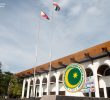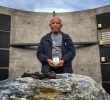By MARILOU M. AGUIRRE | Davao Today

Activists speak out against the Balikatan in Cagayan de Oro City.
DAVAO CITY — An American soldier shot a young man picking scraps of metals in a dumpsite near the US military base in Pampanga. The soldier claimed that he mistook the young man for a boar.
This is a scene in the acclaimed 1976 movie, Minsa’y isang gamugamo (Once a moth), which depicted US troops operating their bases on Philippine soil.
Decades have passed after the movie was released, but the scene is not lost on the people in Mindanao, where more than 600 US troops arrived in Marawi, Lanao del Sur; and in Midsayap and Tacurong in Cotabato early this month as part of Balikatan (shoulder-to-shoulder) joint-military war exercises between US and Filipino troops.
Balikatan 2008 — the 24th in a series since 2002 — kicked off in Bukidnon, Lanao provinces, Cagayan de Oro, Sulu and Basilan on February 18 to March 3 this year.
Protesters belonging to the US Troops Out Now! Mindanao Coalition and Bagong Alyansang Makabayan call the Visiting Forces Agreement (VFA) between the US and the Philippine government — in which Balikatan is a part — as “onerous and one-sided,” citing cases when Filipinos were killed or wounded by US servicemen who are able to escape Philippine laws unscathed.
One of them was Buyung-Buyong Isnijal, 27, who was shot by a certain US Sgt. Reggie Lane while sleeping with his family in barangay (village) Kanas, Tuburan in Basilan.
A team of American and Filipino soldiers raided Isnijal’s house on July 25, 2002. Suspected of being a member of Abu Sayyaf, Isnijal was arrested and detained. His wife was hurt from the scuffle that ensued.
In Malagutay, Zamboanga city, Arsid Baharun, 19, was hit by a stray bullet in 2003 when American and Filipino soldiers had their marksmanship training at their base. Baharun agreed to settle amicably with the US troops to avoid being charged as a member of the Abu Sayyaf.
On November 1, 2005, “Nicole,” a girl from Zamboanga, was raped in Subic, Zambales by US Marine Lance Corporal Daniel Smith who was with other four US marines.
Protesters also cited the attack of a village in Ipil, Maimbung, Sulu by combined elite force of Navy and Army in the early morning of February 4 this year. Seven civilians, four of them minors and a pregnant woman, died. An Army soldier, Pfc. Ibnul Wahid, who was on vacation that time, was also killed in the attack.
Wahid’s wife claimed that US troops were present in the Maimbung massacre.
Military officials issued varying explanations for the killings: that these could be the result of a family feud; that the victims were caught in the crossfire; or that it was a legitimate encounter between government troops and members of the ASG and Jema’ah Islamiyah (JI).
Protesters fear that cases like these will occur again with the holding of war games and the possible building of US bases. But, the US and Philippine governments insisted that American troops were here only to conduct humanitarian missions, such as medical and dental services and building of roads and schools.
Denouncing what they call as government’s “puppetry to US interests,” close to 20,000 protesters in Mindanao took to the streets to demand the pull-out of American troops.
Lawyer Federico Gapuz, chairperson of Union of People’s Lawyers in Mindanao challenged the protesters. “I’ve been fighting US military intervention for as long as fifty years. Can we drive them away in our lifetime?”










